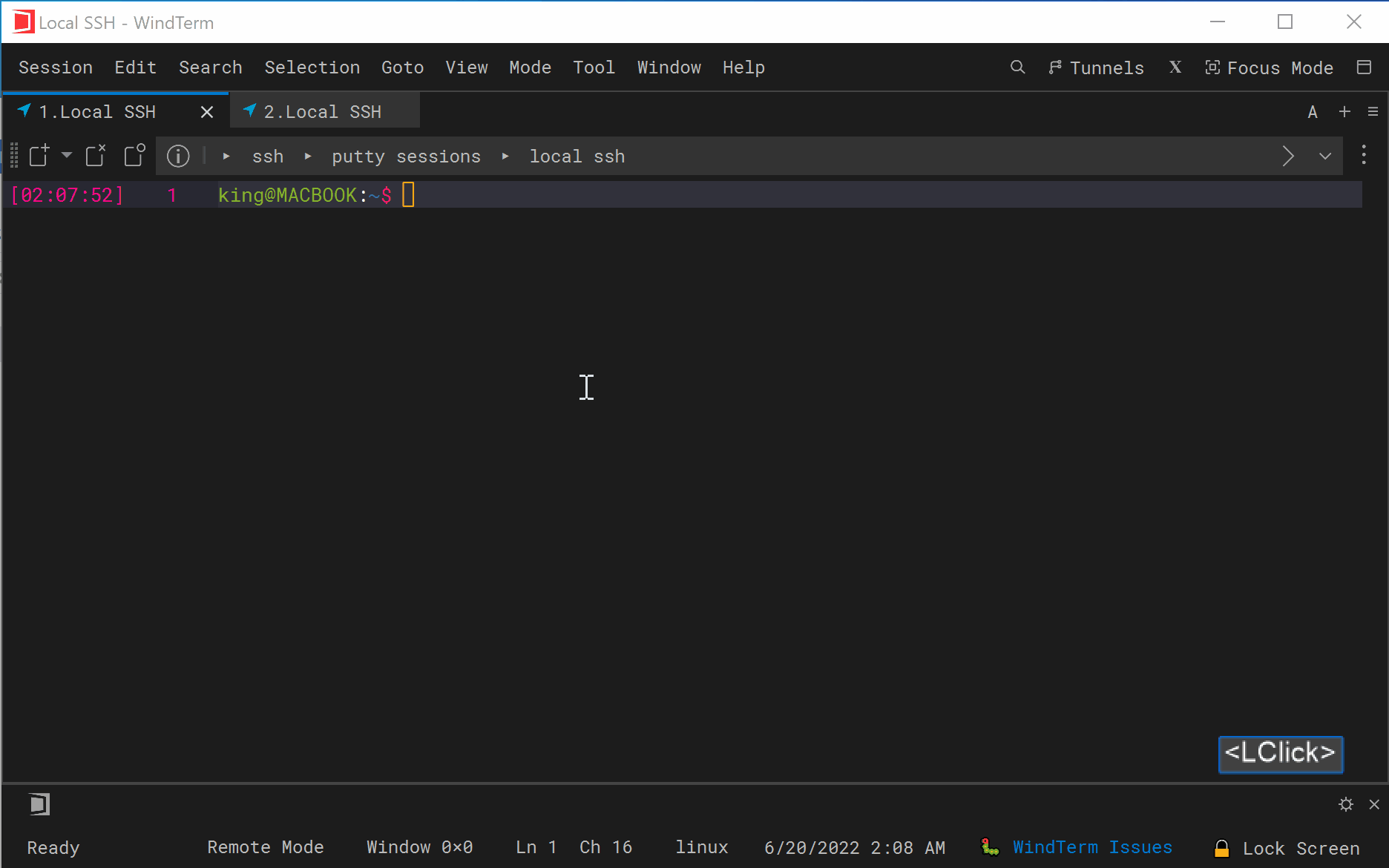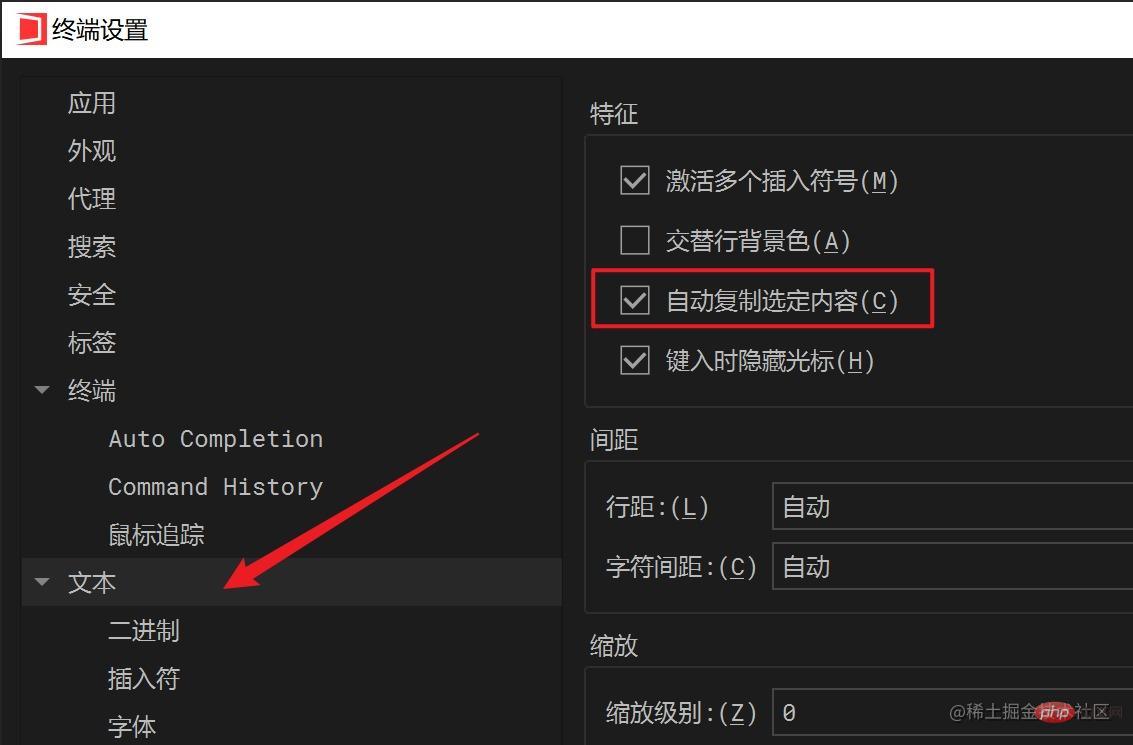 Operation and Maintenance
Operation and Maintenance
 Linux Operation and Maintenance
Linux Operation and Maintenance
 Recommend a Linux terminal artifact: WindTerm!
Recommend a Linux terminal artifact: WindTerm!
Recommend a Linux terminal artifact: WindTerm!
This article brings you relevant knowledge about Linux, and mainly introduces a Linux terminal tool, which can be called an artifact! Friends who are interested can take a look below. I hope it will be helpful to everyone.

#Today I will introduce to you a recently discovered terminal tool that is very powerful and looks very good. I saw this artifact in other public account articles, but they didn’t explain its power clearly, so I experienced it myself and then shared my experience with everyone. "Recommended learning: linux video tutorial"
This artifact is—— WindTerm!
I have used many terminal tools before, such as SecurCRT, XShell, Putyy, and MobaXterm. But when I first saw WindTerm, I was deeply attracted.

It is a cross-platform (Windows, MacOS, Linux) SSH client developed in C language, completely free for commercial and non-commercial use, without restrictions. All distributed source code (except third-party directories) is provided under the terms of the Apache-2.0 license.
Main features:
Support SSH, Telnet, Tcp, Shell, Serial
Supports SSH v2, Telnet, Raw Tcp, serial, and Shell protocols.
Support SSH automatic execution during session authentication.
Support SSH ControlMaster.
Supports SSH ProxyCommand or ProxyJump.
Support SSH agent forwarding.
Supports SSH automatic login using password, public key, keyboard interaction, and gssapi-with-mic.
Supports X11 forwarding.
Supports direct/local port forwarding, reverse/remote port forwarding and dynamic port forwarding.
Supports XModem, YModem and ZModem.
Integrate sftp and scp clients, support downloading, uploading, deleting, renaming, creating new Recommend a Linux terminal artifact: WindTerm!s/directories, etc.
Integrated local Recommend a Linux terminal artifact: WindTerm! manager, supports moving to, copying to, copying from, deleting, renaming, creating new Recommend a Linux terminal artifact: WindTerm!s/directories, etc.
Supports Windows Cmd, PowerShell and Cmd, PowerShell as administrator.
Supports Linux bash, zsh, powershell core, etc.
Supports MacOS bash, zsh, powershell core, etc.
Based on my experience of using it these days, I would like to share with you some features that really shocked me.
The following animation comes from the author's blog. I wanted to record it myself, but the resulting gif Recommend a Linux terminal artifact: WindTerm! was very large. Is there anyone who can teach me?
1. The power of WindTerm
1. Auto-completion function
The auto-completion function is simply good news for our programmers! Think about how much time the auto-completion function saves us when we write code?
WindTerm It also comes with an auto-completion function. This is the first time I have seen this in a terminal tool. In the past, when we typed commands, we completed the commands by continuously tapping the Tab key. Now, we no longer need to type the Tab key.

2. Powerful historical backtracking function
Generally, if we need to view previously entered commands, we use history Order. And WindTerm will bring you a window of history commands directly on the right side, so you can save even the history command!

And it also has a filtering function, you don’t even have to grep anymore, this is so considerate!
If you want to re-execute a certain command, just double-click the corresponding command. Before, we also needed to remember the number of the historical command and then use ! to re-execute it.
Of course you can still use !, but it will strengthen it for you. Not only can you re-execute commands in the current session, but you can also retrace commands you entered in other sessions!

3. Quick command
The so-called quick command is similar to a script. You can put the command to be executed in the quick command and then execute it. This quick command will execute the commands inside in order.
It’s a bit hard to pronounce, isn’t it? Give me a picture and everyone will understand.

(How did this window come out? Just click the small gear in the lower right corner)
Then, click on the name of the quick command you created in the lower left corner to automatically execute the commands you just entered in order.

#If you don’t know how to write scripts, this feature is also a blessing. (Are there programmers who don’t know how to write scripts?? Hurry up and take a picture of the course at the end of my article [smiley face])
4. Free input mode
In other terminal tools, we enter commands When typing, you can only type letters in order. If you forget to type an option or parameter in the middle, you need to move the cursor to go back and make up for it.
Early computers did not have a mouse, so this operation is understandable.
But now, almost all text editors support mouse operations, such as clicking on a certain location and entering text, selecting text to delete, dragging text to other locations, etc.
Other terminal tools I have seen basically do not support such operations, but WindTerm It actually supports it! ! Not only in the command window, but also supports Vim, Emac and other editors!
The effect of using it is very similar to Word!
Insert as you want, delete as you want, drag as you want, it’s so convenient!
5. Highly customized interface
We can see that the interface of WindTerm contains a lot of content, but some columns may not be what we need, then It can be removed or customized.
This customizable interface is really powerful!
Customized column:

Customized Dock:

Split screen function:

#6. Synchronous input function
If you are an operation and maintenance programmer , there may be a need to input a certain command to multiple servers at the same time.
I don’t know about other terminal tools (I haven’t seen any that I have used), but WindTerm has already fulfilled this requirement, which is another amazing function!

WindTerm also has many powerful functions, such as Recommend a Linux terminal artifact: WindTerm! upload and download, automatic screen lock, springboard, XModem, YModem, ZModem, etc. .
Create session
Menu--> Session--> New sessionpops up Enter the host name in the window and leave the rest as default. Of course, if you want to set labels and group, it also supports it.

Automatically copy the selected content
My general usage habit is to automatically copy text when selected with the mouse, and then right-click to automatically paste. However, many terminals now do not have such a function turned on by default and need to be turned on manually. Menu Bar--> Session--> Preferences--> Settings
Menu Bar--> Session--> Preferences--> Settings
 ##Turn off mouseover on label Automatically activate label function
##Turn off mouseover on label Automatically activate label function
WindTerm
There is a function that I don’t like very much, that is, when you put the mouse on a label, it will automatically activate that label. We can turn this feature off manually.Menu Bar--> Session--> Preferences--> Settings
 Use this The terminal has been around for a while, and I really admire the author for developing such a powerful tool.
Use this The terminal has been around for a while, and I really admire the author for developing such a powerful tool.
I have been bragging about MobaXterm before. If you don’t tell me, I will fall in love with another person, haha~
However, there is no best tool, only the tool that suits you best. Along the way, I used Putty, SecureCRT, and MobaXterm successively, and also tried many other terminal tools, such as FishShell, Termius, iTerm, and XShell, but finally stayed at MobaXterm.
When I introduced MobaXterm, many people said it was stuck, but I really didn’t feel it after using it. So I have been saying that tools are tools after all, and the most convenient ones are the best , including WindTerm.
The above is the detailed content of Recommend a Linux terminal artifact: WindTerm!. For more information, please follow other related articles on the PHP Chinese website!

Hot AI Tools

Undresser.AI Undress
AI-powered app for creating realistic nude photos

AI Clothes Remover
Online AI tool for removing clothes from photos.

Undress AI Tool
Undress images for free

Clothoff.io
AI clothes remover

Video Face Swap
Swap faces in any video effortlessly with our completely free AI face swap tool!

Hot Article

Hot Tools

Notepad++7.3.1
Easy-to-use and free code editor

SublimeText3 Chinese version
Chinese version, very easy to use

Zend Studio 13.0.1
Powerful PHP integrated development environment

Dreamweaver CS6
Visual web development tools

SublimeText3 Mac version
God-level code editing software (SublimeText3)

Hot Topics
 1387
1387
 52
52
 How to use docker desktop
Apr 15, 2025 am 11:45 AM
How to use docker desktop
Apr 15, 2025 am 11:45 AM
How to use Docker Desktop? Docker Desktop is a tool for running Docker containers on local machines. The steps to use include: 1. Install Docker Desktop; 2. Start Docker Desktop; 3. Create Docker image (using Dockerfile); 4. Build Docker image (using docker build); 5. Run Docker container (using docker run).
 How to view the docker process
Apr 15, 2025 am 11:48 AM
How to view the docker process
Apr 15, 2025 am 11:48 AM
Docker process viewing method: 1. Docker CLI command: docker ps; 2. Systemd CLI command: systemctl status docker; 3. Docker Compose CLI command: docker-compose ps; 4. Process Explorer (Windows); 5. /proc directory (Linux).
 What to do if the docker image fails
Apr 15, 2025 am 11:21 AM
What to do if the docker image fails
Apr 15, 2025 am 11:21 AM
Troubleshooting steps for failed Docker image build: Check Dockerfile syntax and dependency version. Check if the build context contains the required source code and dependencies. View the build log for error details. Use the --target option to build a hierarchical phase to identify failure points. Make sure to use the latest version of Docker engine. Build the image with --t [image-name]:debug mode to debug the problem. Check disk space and make sure it is sufficient. Disable SELinux to prevent interference with the build process. Ask community platforms for help, provide Dockerfiles and build log descriptions for more specific suggestions.
 What computer configuration is required for vscode
Apr 15, 2025 pm 09:48 PM
What computer configuration is required for vscode
Apr 15, 2025 pm 09:48 PM
VS Code system requirements: Operating system: Windows 10 and above, macOS 10.12 and above, Linux distribution processor: minimum 1.6 GHz, recommended 2.0 GHz and above memory: minimum 512 MB, recommended 4 GB and above storage space: minimum 250 MB, recommended 1 GB and above other requirements: stable network connection, Xorg/Wayland (Linux)
 vscode cannot install extension
Apr 15, 2025 pm 07:18 PM
vscode cannot install extension
Apr 15, 2025 pm 07:18 PM
The reasons for the installation of VS Code extensions may be: network instability, insufficient permissions, system compatibility issues, VS Code version is too old, antivirus software or firewall interference. By checking network connections, permissions, log files, updating VS Code, disabling security software, and restarting VS Code or computers, you can gradually troubleshoot and resolve issues.
 Can vscode be used for mac
Apr 15, 2025 pm 07:36 PM
Can vscode be used for mac
Apr 15, 2025 pm 07:36 PM
VS Code is available on Mac. It has powerful extensions, Git integration, terminal and debugger, and also offers a wealth of setup options. However, for particularly large projects or highly professional development, VS Code may have performance or functional limitations.
 What is vscode What is vscode for?
Apr 15, 2025 pm 06:45 PM
What is vscode What is vscode for?
Apr 15, 2025 pm 06:45 PM
VS Code is the full name Visual Studio Code, which is a free and open source cross-platform code editor and development environment developed by Microsoft. It supports a wide range of programming languages and provides syntax highlighting, code automatic completion, code snippets and smart prompts to improve development efficiency. Through a rich extension ecosystem, users can add extensions to specific needs and languages, such as debuggers, code formatting tools, and Git integrations. VS Code also includes an intuitive debugger that helps quickly find and resolve bugs in your code.
 How to back up vscode settings and extensions
Apr 15, 2025 pm 05:18 PM
How to back up vscode settings and extensions
Apr 15, 2025 pm 05:18 PM
How to back up VS Code configurations and extensions? Manually backup the settings file: Copy the key JSON files (settings.json, keybindings.json, extensions.json) to a safe location. Take advantage of VS Code synchronization: enable synchronization with your GitHub account to automatically back up all relevant settings and extensions. Use third-party tools: Back up configurations with reliable tools and provide richer features such as version control and incremental backups.



